Volcanoes/Io
< Volcanoes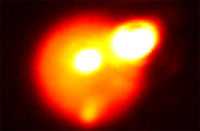
Io is a rocky object that occurs in the Solar System.
In turn, rocky-object astronomy is used to study Io.
Volcanic activity
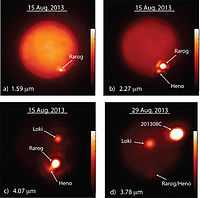
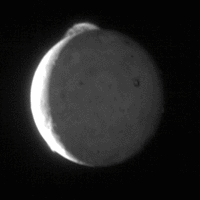

"One of Jupiter’s moons has unleashed a series of huge volcanic eruptions [imaged at the top of the page] over a hellish 2 week period that were so bright they could be studied in detail by ground based observatories."[1]
“We typically expect one huge outburst every one or two years, and they’re usually not this bright.”[2]
“Here we had three extremely bright outbursts, which suggest that if we looked more frequently we might see many more of them on Io.”[2]
“These new events are in a relatively rare class of eruptions on Io because of their size and astonishingly high thermal emission. The amount of energy being emitted by these eruptions implies lava fountains gushing out of fissures at a very large volume per second, forming lava flows that quickly spread over the surface of Io.”[3]
"While recording the eruptions that occurred in the moon’s southern hemisphere on Aug. 15, 2013, the researchers saw the brightest emanate from a caldera called Rarog Patera, which produced a 50 square-mile, 30 foot-thick lava flow — enough lava to cover Manhattan Island. Another eruption that was generated by the caldera Heno Patera produced a flow covering 120 square miles. Both eruptions generated “curtains of fire” as lava blasted from long fissures in Io’s crust."[1]
"Images [on the right are] of Io obtained at different infrared wavelengths (in microns, μm, or millionths of a meter) with the W. M. Keck Observatory’s 10-meter Keck II telescope on Aug. 15, 2013 (a-c) and the Gemini North telescope on Aug. 29, 2013 (d). The bar on the right of each image indicates the intensity of the infrared emission. Note that emissions from the large volcanic outbursts on Aug. 15 at Rarog and Heno Paterae have substantially faded by Aug. 29. A second bright spot is visible to the north of the Rarog and Heno eruptions in c and to the west of the outburst in d. This hot spot was identified as Loki Patera, a lava lake that appeared to be particularly active at the same time."[2]
On the left is a five-image sequence of New Horizons images showing Io's volcano Tvashtar spewing material 330 km above its surface.
The pair of images on the right changes in surface features for the eight years between Galileo and New Horizons observations.
Theoretical volcanic Io
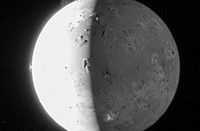
"Io is Jupiter’s innermost Galilean moon that is 2,300 miles wide, approximately the same size as our moon, and is the only place in the solar system (except Earth) where active volcanoes have been observed. The volcanic activity is driven by powerful tidal interactions with the gas giant that squeeze Io’s interior, heating it up. Like Earth’s volcanoes, molten rock (magma) is then forced through Io’s crust intermittently erupting as volcanoes."[1]
"Io is the most volcanic body in the solar system, boasting activity 25 times that of Earth. Some of Io's volcanoes blast plumes of sulfur and other material 250 miles (400 kilometers) above the moon, which is completely resurfaced every million years or so. On Thursday (April 4), NASA released a video of Io's volcano plumes based on five images snapped by the agency's Pluto-bound New Horizons spacecraft in March 2007."[4] One of these frames is on the right.
"The hundreds of volcanoes on Jupiter's moon Io aren't where they're supposed to be, [...] Io's major volcanic activity is concentrated 30 to 60 degrees farther east than models of its internal heat profile predict".[4]
"The unexpected eastward offset of the volcano locations is a clue that something is missing in our understanding of Io. In a way, that's our most important result. Our understanding of tidal heat production and its relationship to surface volcanism is incomplete."[5]
"This intense activity is ultimately generated by gravitational tugs from Jupiter, with an assist from the nearby moons Europa and Ganymede."[4]
"Io completes two orbits for every one that Europa makes, and four for every one of Ganymede's laps. As a result of this regular timing, Europa and Ganymede have pulled the orbit of Io into an oval, with explosive consequences for the 2,260-mile-wide (3,640 km) moon."[4]
"As Io moves closer to Jupiter, the planet's powerful gravity pulls hard on the moon, deforming it. This force decreases as Io retreats, and the moon bounces back. This cycle of flexing creates friction in Io's interior, which in turn generates enormous amounts of volcano-driving tidal heat."[4]
"Common sense suggests that Io's volcanoes would be located above the spots with the most dramatic internal heating."[4]
"What's causing the disconnect between expected and observed volcano locations remains a mystery. It's possible that Io is rotating faster than scientists think, researchers said. Or models of Io's tidal heating may be missing some components, such as the complications caused by an underground magma ocean."[4]
"Our analysis supports a global subsurface magma ocean scenario as one possible explanation for the offset between predicted and observed volcano locations on Io. However, Io's magma ocean would not be like the oceans on Earth. Instead of being a completely fluid layer, Io's magma ocean would probably be more like a sponge with at least 20 percent silicate melt within a matrix of slowly deformable rock."[5]
Volcanisms

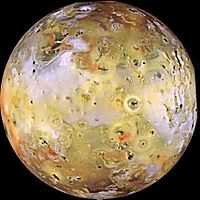
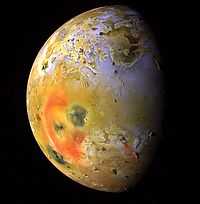
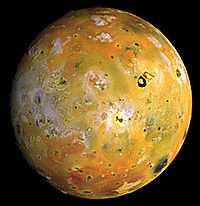
_from_Galileo_and_Voyager_missions.jpg)
_from_Galileo_and_Voyager_missions.jpg)
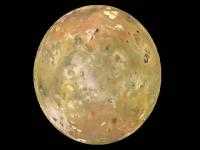
"The view [on the right] includes two of Io's ten highest peaks, the Euboea Montes at upper extreme left and Haemus Mons at bottom."[1] This mosaic of Voyager 1 images covers Io's south polar region. On the left is a mosaic of Voyager 1 images covering Io's south polar region. The view includes two of Io's ten highest peaks, the Euboea Montes at upper extreme left and Haemus Mons at bottom. Io "is the innermost of the four Galilean moons of the planet Jupiter and, with a diameter of 3,642 kilometres (2,263 mi), the fourth-largest moon in the Solar System. ... With over 400 active volcanoes, Io is the most geologically active object in the Solar System.[6][7] ... Most of Io's surface is characterized by extensive plains coated with sulfur and sulfur dioxide frost. ... Io's volcanism is responsible for many of the satellite's unique features. Its volcanic plumes and lava flows produce large surface changes and paint the surface in various shades of yellow, red, white, black, and green, largely due to allotropes and compounds of sulfur."[8]
In the image at right, "[t]he smallest features that can be discerned are 2.5 kilometers in size. There are rugged mountains several kilometers high, layered materials forming plateaus, and many irregular depressions called volcanic calderas. Several of the dark, flow-like features correspond to hot spots, and may be active lava flows. There are no landforms resembling impact craters, as the volcanism covers the surface with new deposits much more rapidly than the flux of comets and asteroids can create large impact craters. The picture is centered on the side of Io that always faces away from Jupiter; north is to the top."[9]
"Color images acquired on September 7, 1996 have been merged with higher resolution images acquired on November 6, 1996 by the Solid State Imaging (CCD) system aboard NASA's Galileo spacecraft. The color is composed of data taken, at a range of 487,000 kilometers, in the near-infrared, green, and violet filters and has been enhanced to emphasize the extraordinary variations in color and brightness that characterize Io's face. The high resolution images were obtained at ranges which varied from 245,719 kilometers to 403,100 kilometers."[9]
The second image at right is a "global view of Jupiter's moon, Io, ... obtained during the tenth orbit of Jupiter by NASA's Galileo spacecraft. Io, which is slightly larger than Earth's moon, is the most volcanically active body in the solar system. In this enhanced color composite, deposits of sulfur dioxide frost appear in white and grey hues while yellowish and brownish hues are probably due to other sulfurous materials. Bright red materials, such as the prominent ring surrounding Pele, and "black" spots with low brightness mark areas of recent volcanic activity and are usually associated with high temperatures and surface changes. One of the most dramatic changes is the appearance of a new dark spot (upper right edge of Pele), 400 kilometers (250 miles)in diameter which surrounds a volcanic center named Pillan Patera. The dark spot did not exist in images obtained 5 months earlier, but Galileo imaged a 120 kilometer (75 mile) high plume erupting from this location during its ninth orbit. North is to the top of the picture which was taken on September 19, 1997 at a range of more than 500,000 kilometers (310,000 miles) by the Solid State Imaging (SSI) system on NASA's Galileo spacecraft."[10]
The third image at right continues around Io to the left.
The fourth image is of Io's north pole. "[The] new basemap [and the polar images] of Jupiter's moon Io was produced by combining the best images from both the Voyager 1 and Galileo Missions. Although the subjovian hemisphere of Io was poorly seen by Galileo, superbly detailed Voyager 1 images cover longitudes from 240 W to 40 W and the nearby southern latitudes. A monochrome mosaic of the highest resolution images from both Galileo and Voyager 1 was assembled that includes 51 Voyager 1 images with spatial resolutions sometimes exceeding the 1 km/pixel scale of the final mosaic. Because this mosaic is made up of images taken at various local times of day, care must be taken to note the solar illumination direction when deciding whether topographic features display positive or negative relief. In general, the illumination is from the west over longitudes 40 to 270 W, and from the east over longitudes 270 W to 40 W. Color information was later superimposed from Galileo low phase angle violet, green, and near-infrared (756 nanometer wavelength) images. The Galileo SSI camera's silicon CCD was sensitive to longer wavelengths than the vidicon cameras of Voyager, so that distinctions between red and yellow hues can be more easily discerned. The "true" colors that would be visible to the eye are similar but much more muted than shown here. Image resolutions range from 1 to 10 km/pixel along the equator, with the poorest coverage centered on longitude 50 W."[11]
The fifth image is of Io's south pole.
The last image is an animated image showing a 1 Io day of rotation. "In the same way that the Moon always has the same side facing Earth, Io always has the same side facing Jupiter. The movie shows two speeded-up rotations of Io (a single rotation really takes 1.77 days), and begins with a view of the Jupiter-facing hemisphere. With rotation in an easterly direction, after two seconds the volcano Prometheus (on the equator) comes into view. The massive red deposit around Pele (seconds 5-10) is the most distinctive expression of volcanic activity on Io, and just to the north-west is the horse shoe-shaped Loki Patera, the most powerful volcano on Io. The animation was made using a computer program that wrapped the Io mosaic around a sphere to produce a globe. In all, 360 images were used, each differing by one degree in longitude from the previous image."[12]
Volcanic rocks
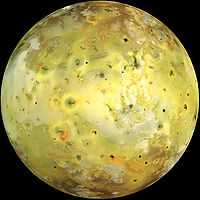
The surface of Io appears to be composed entirely of volcanic rocks as suggested by the image on the right.
Research
Hypothesis:
- Io is more volcanic than any rocky-object of its size because of the electrical currents running through it.
Control groups

The findings demonstrate a statistically systematic change from the status quo or the control group.
“In the design of experiments, treatments [or special properties or characteristics] are applied to [or observed in] experimental units in the treatment group(s).[13] In comparative experiments, members of the complementary group, the control group, receive either no treatment or a standard treatment.[14]"[15]
Proof of concept
Def. a “short and/or incomplete realization of a certain method or idea to demonstrate its feasibility"[16] is called a proof of concept.
Def. evidence that demonstrates that a concept is possible is called proof of concept.
The proof-of-concept structure consists of
- background,
- procedures,
- findings, and
- interpretation.[17]
See also
References
- 1 2 3 4 Ian O'Neill (4 August 2014). "Jupiter Moon Io Unleashes Cataclysmic Eruptions". Discovery.com. Retrieved 2015-05-10.
- 1 2 3 Imke de Pater (4 August 2014). "Jupiter Moon Io Unleashes Cataclysmic Eruptions". Discovery.com. Retrieved 2015-05-10.
- ↑ Ashley Davies (4 August 2014). "Jupiter Moon Io Unleashes Cataclysmic Eruptions". Discovery.com. Retrieved 2015-05-10.
- 1 2 3 4 5 6 7 Mike Wall (6 April 2013). "Volcanoes on Jupiter's Moon Io Are All Wrong". Space.com. Retrieved 2015-05-11.
- 1 2 Christopher Hamilton (6 April 2013). "Volcanoes on Jupiter's Moon Io Are All Wrong". Space.com. Retrieved 2015-05-11.
- ↑ Rosaly MC Lopes (2006). "Io: The Volcanic Moon". In Lucy-Ann McFadden, Paul R. Weissman, Torrence V. Johnson. Encyclopedia of the Solar System. Academic Press. pp. 419–431. ISBN 978-0-12-088589-3.
- ↑ R. M. C. Lopes et al. (2004). "Lava lakes on Io: Observations of Io’s volcanic activity from Galileo NIMS during the 2001 fly-bys". Icarus 169 (1): 140–74. doi:10.1016/j.icarus.2003.11.013.
- ↑ "Io (moon), In: Wikipedia". San Francisco, California: Wikimedia Foundation, Inc. June 7, 2012. Retrieved 2012-06-08.
- 1 2 "File:Iosurface gal.jpg, In: Wikimedia Commons". San Francisco, California: Wikimedia Foundation, Inc. September 15, 2011. Retrieved 2012-07-17.
- ↑ "File:PIA01667-Io's Pele Hemisphere After Pillan Changes.jpg, In: Wikimedia Commons". San Francisco, California: Wikimedia Foundation, Inc. September 15, 2010. Retrieved 2012-07-17.
- ↑ "File:Io (north pole) from Galileo and Voyager missions.jpg, In: Wikimedia Commons". San Francisco, California: Wikimedia Foundation, Inc. September 19, 2011. Retrieved 2012-07-18.
- ↑ "File:Iorotateing1day.ogg. In: Wikimedia Commons". San Francisco, California: Wikimedia Foundation, Inc. August 3, 2011. Retrieved 2012-07-18.
- ↑ Klaus Hinkelmann, Oscar Kempthorne (2008). Design and Analysis of Experiments, Volume I: Introduction to Experimental Design (2nd ed.). Wiley. ISBN 978-0-471-72756-9. http://books.google.com/?id=T3wWj2kVYZgC&printsec=frontcover.
- ↑ R. A. Bailey (2008). Design of comparative experiments. Cambridge University Press. ISBN 978-0-521-68357-9. http://www.cambridge.org/uk/catalogue/catalogue.asp?isbn=9780521683579.
- ↑ "Treatment and control groups, In: Wikipedia". San Francisco, California: Wikimedia Foundation, Inc. May 18, 2012. Retrieved 2012-05-31.
- ↑ "proof of concept, In: Wiktionary". San Francisco, California: Wikimedia Foundation, Inc. November 10, 2012. Retrieved 2013-01-13.
- ↑ Ginger Lehrman and Ian B Hogue, Sarah Palmer, Cheryl Jennings, Celsa A Spina, Ann Wiegand, Alan L Landay, Robert W Coombs, Douglas D Richman, John W Mellors, John M Coffin, Ronald J Bosch, David M Margolis (August 13, 2005). "Depletion of latent HIV-1 infection in vivo: a proof-of-concept study". Lancet 366 (9485): 549-55. doi:10.1016/S0140-6736(05)67098-5. http://www.ncbi.nlm.nih.gov/pmc/articles/PMC1894952/. Retrieved 2012-05-09.
External links
| |||||||||||||||||||||||||||||||||||
| |
Development status: this resource is experimental in nature. |
| |
Educational level: this is a research resource. |
| |
Resource type: this resource is an article. |
| |
Resource type: this resource contains a lecture or lecture notes. |
| |
Subject classification: this is an astronomy resource. |
| |
Subject classification: this is a Geology resource. |